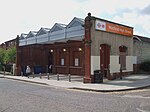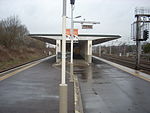Bushey railway station
1841 establishments in EnglandDfT Category E stationsFormer London and North Western Railway stationsLondon stations without latest usage statistics 1415London stations without latest usage statistics 1516 ... and 9 more
London stations without latest usage statistics 1617Proposed London Underground stationsRail transport stations in London fare zone 8Railway stations in Great Britain opened in 1841Railway stations in WatfordRailway stations served by London OvergroundRailway stations served by West Midlands TrainsStations on the West Coast Main LineUse British English from August 2012

Bushey is a railway station in Hertfordshire which serves Bushey and Oxhey. It is situated on the West Coast Main Line, 5 miles (8 km) north of Harrow & Wealdstone, on an embankment. North of the station, the railway crosses the Colne valley on several viaducts. The station is served by London Northwestern Railway semi-fast trains on the West Coast main line, and by London Overground services on the Watford DC line, a slow local service along the West Coast route. At Bushey, this branches west on a loop to serve Watford High Street railway station, before rejoining the main line at Watford Junction.
Excerpt from the Wikipedia article Bushey railway station (License: CC BY-SA 3.0, Authors, Images).Bushey railway station
Bushey and Oxhey Railway Yard,
Geographical coordinates (GPS) Address Nearby Places Show on map
Geographical coordinates (GPS)
| Latitude | Longitude |
|---|---|
| N 51.644 ° | E -0.385 ° |
Address
Bushey and Oxhey Railway Yard
Bushey and Oxhey Railway Yard
WD19 4EA , Watford Heath
England, United Kingdom
Open on Google Maps






